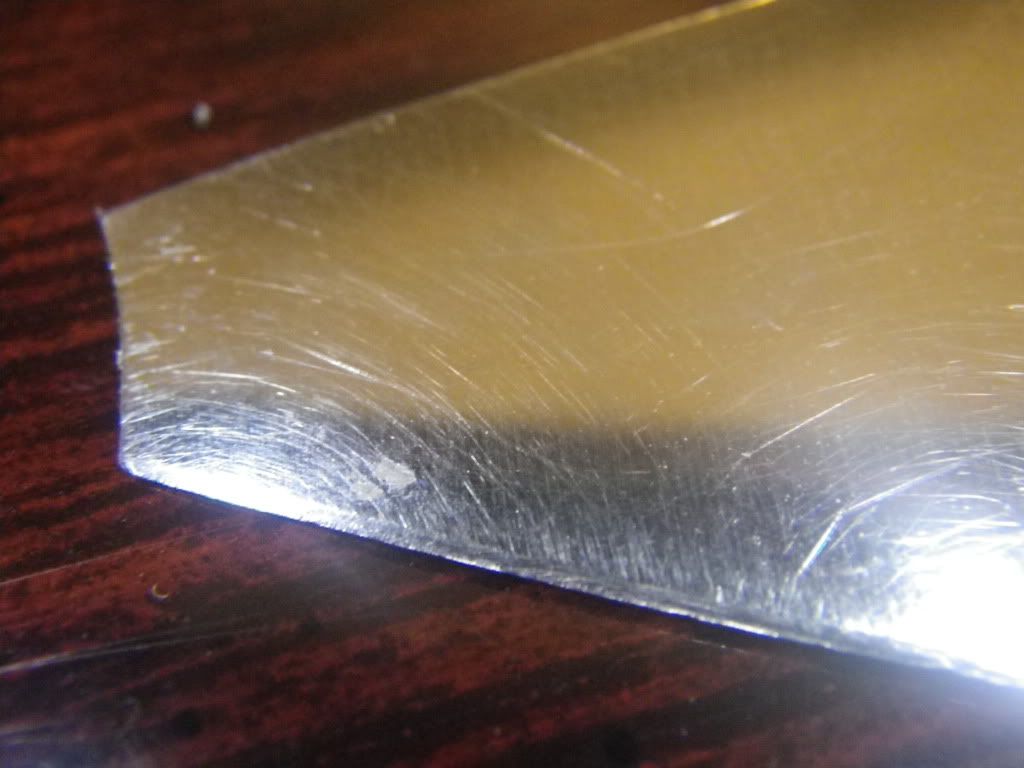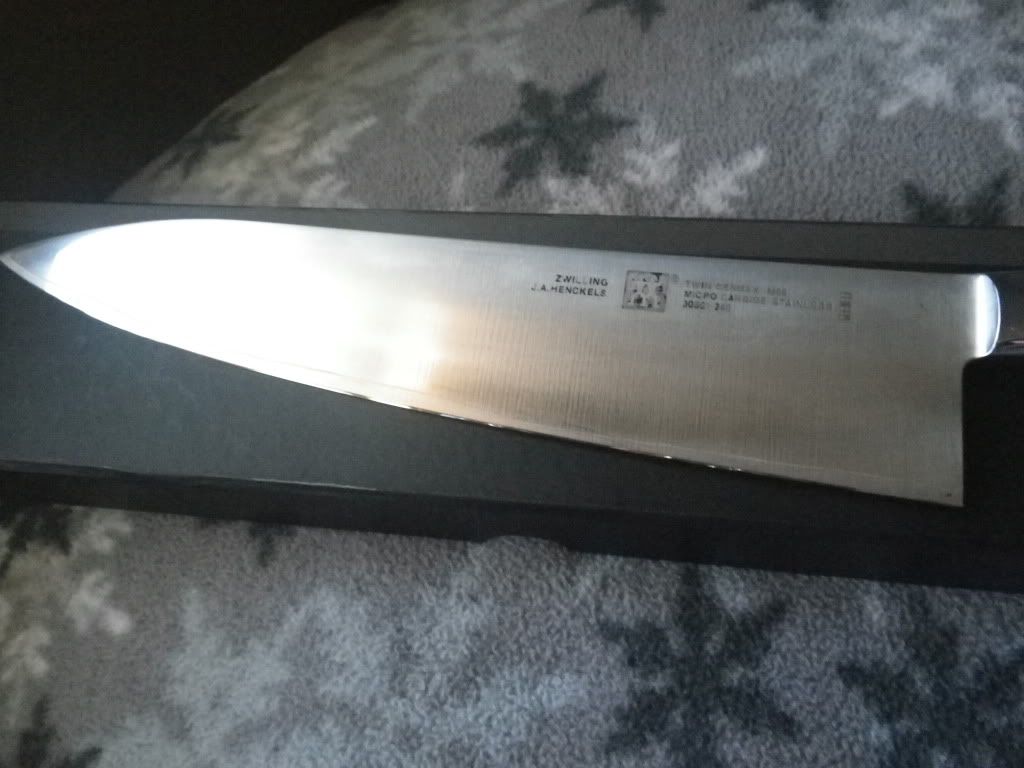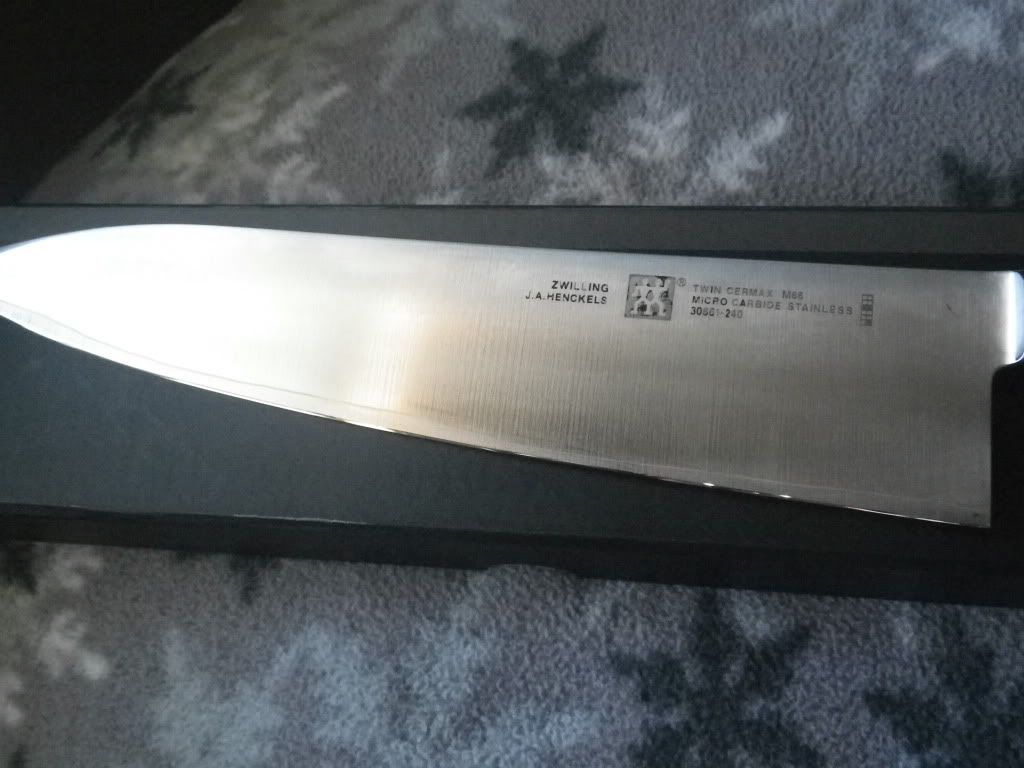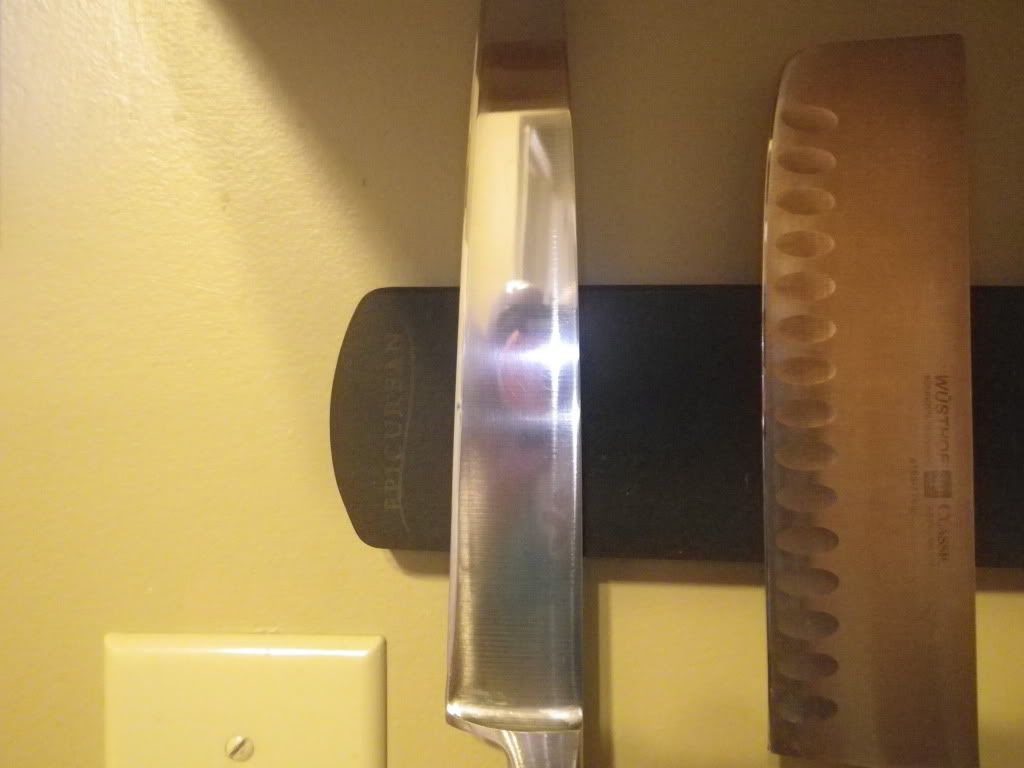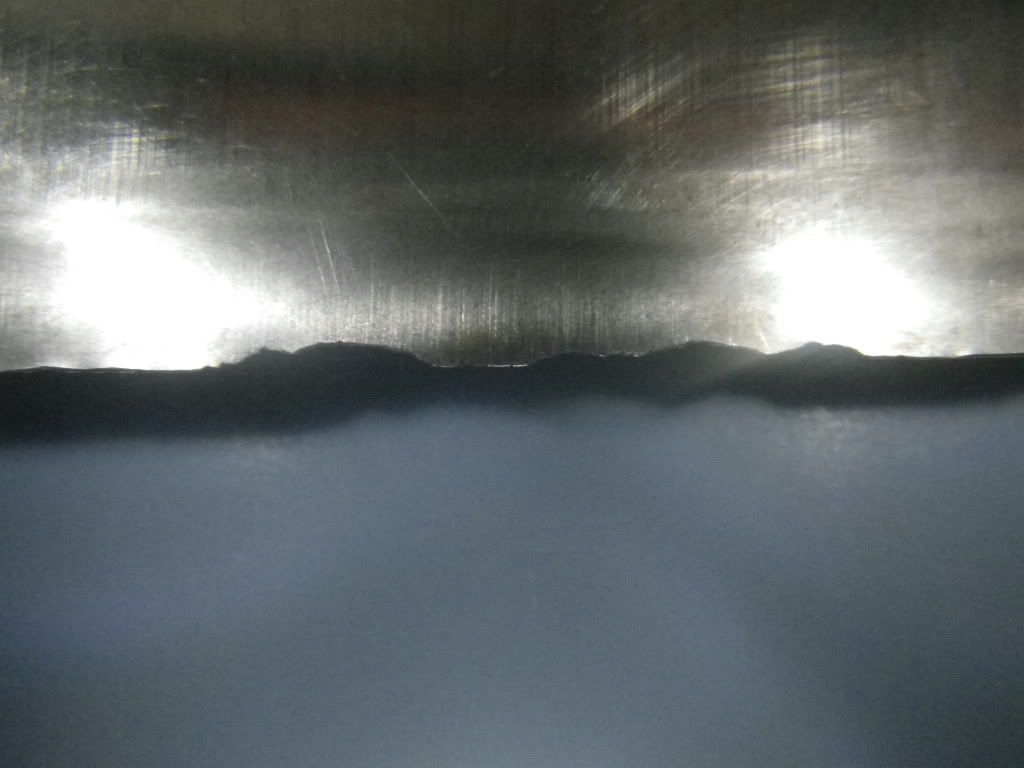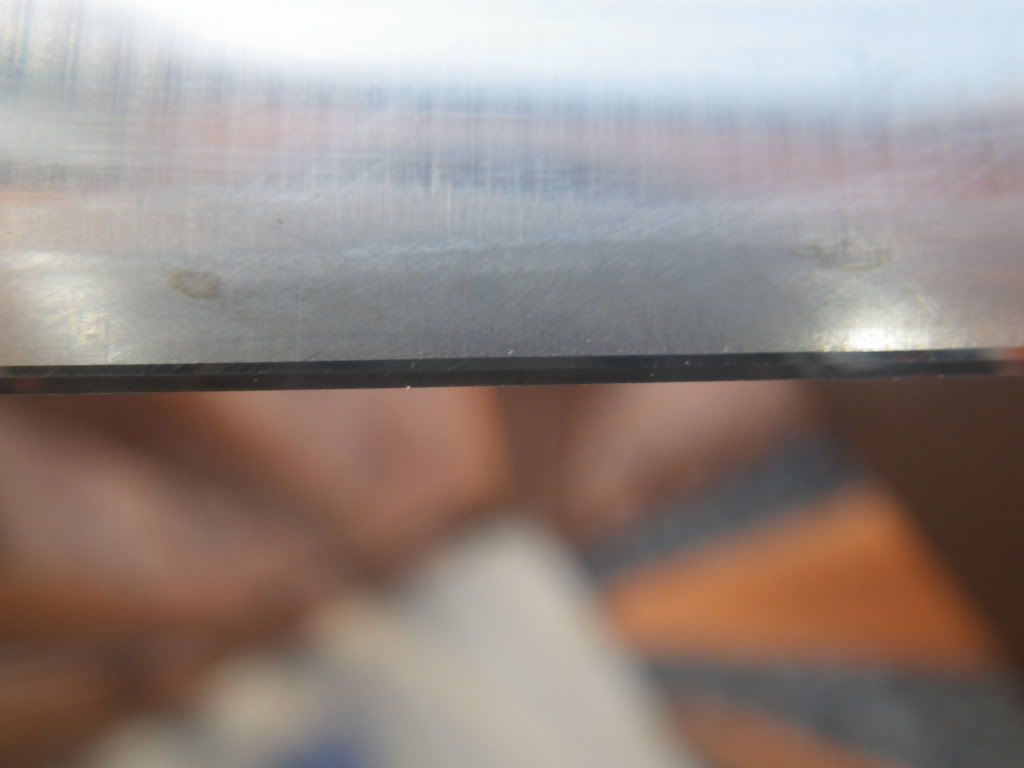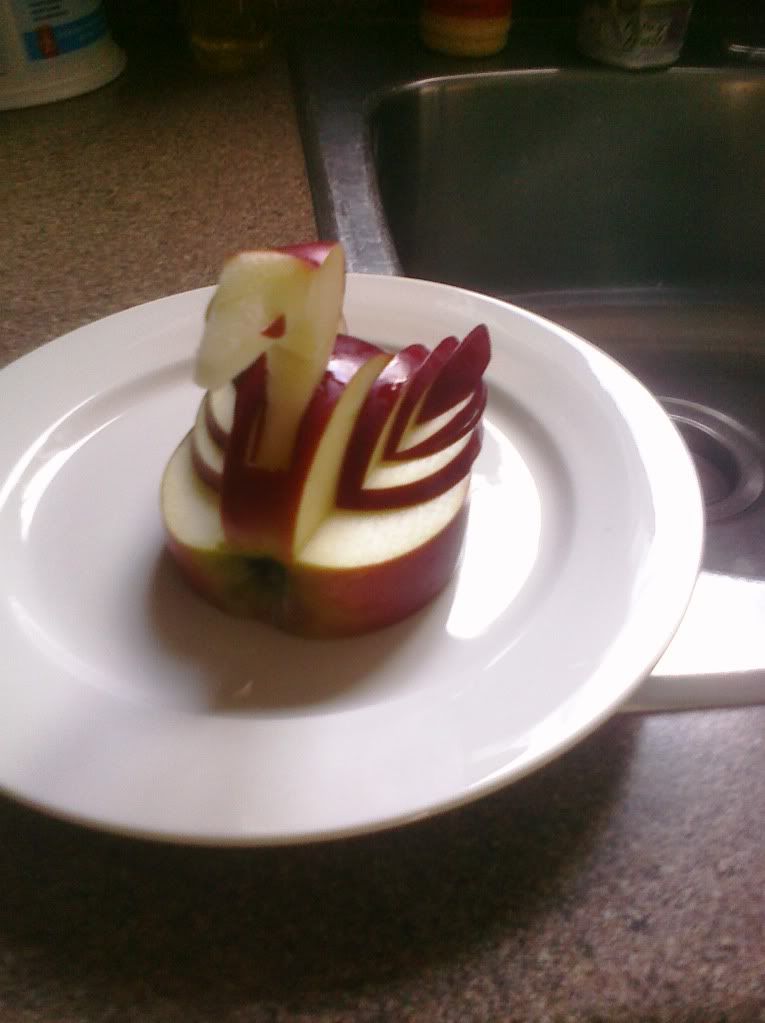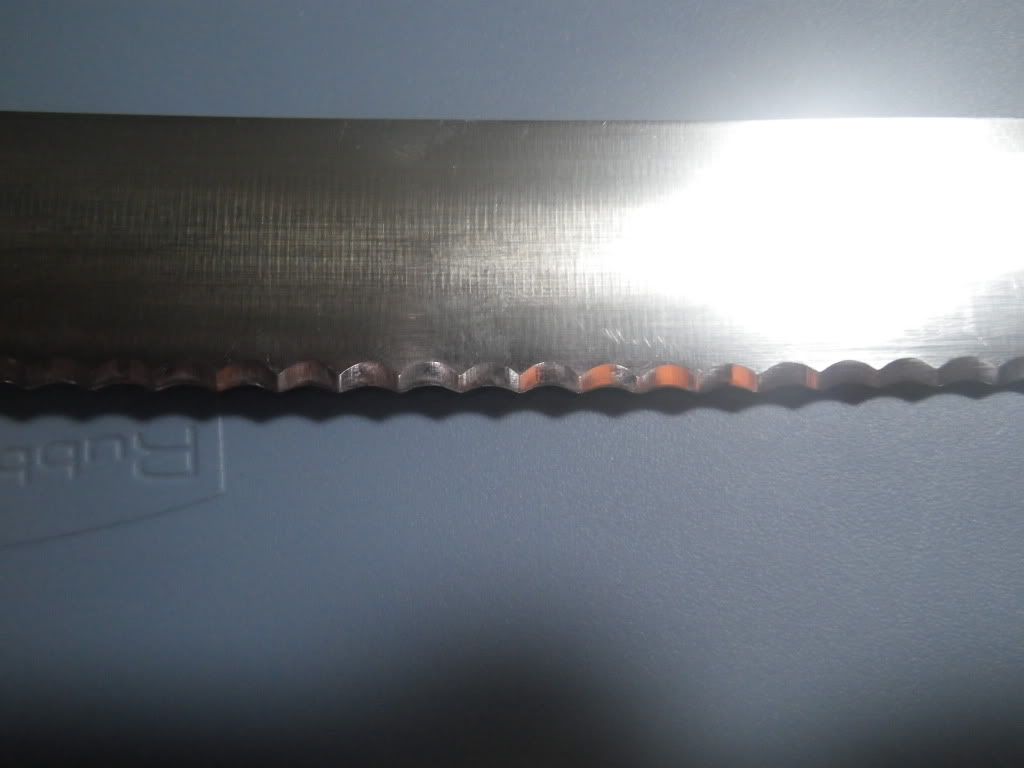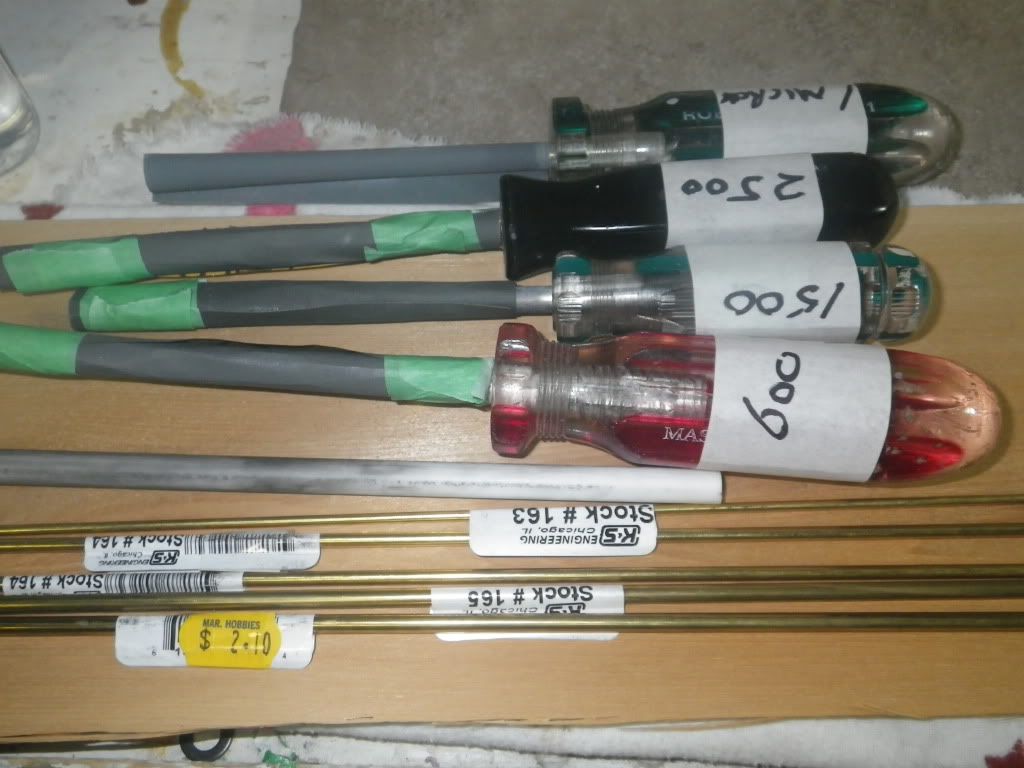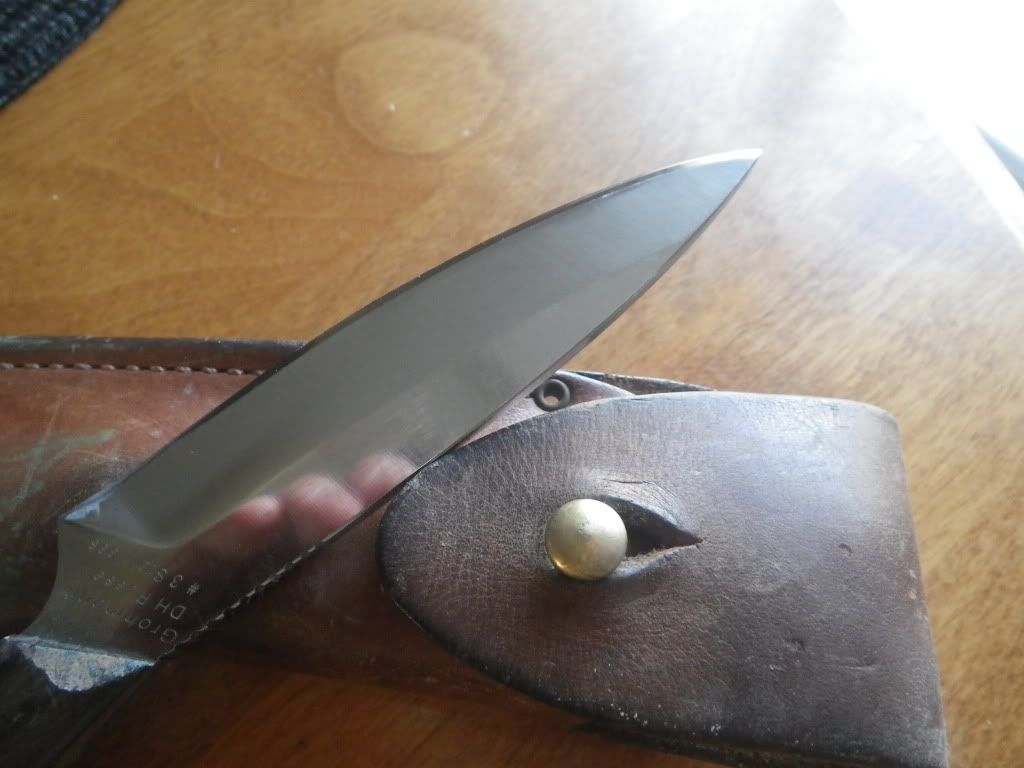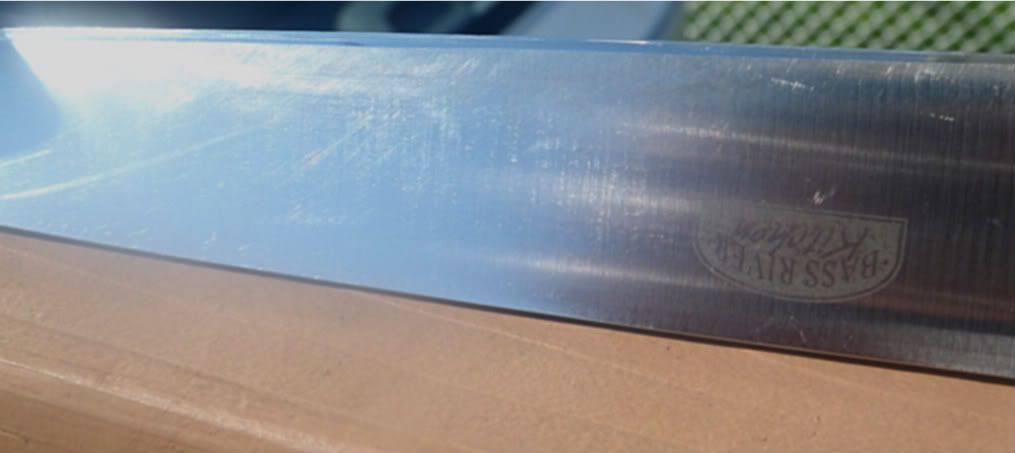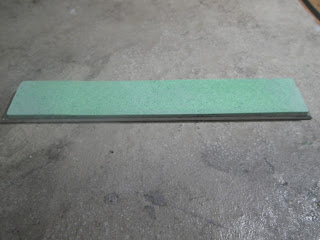This was something I hadn't had the opportunity to sharpen before, the angle on the edge is much steeper than any kitchen knife except for a cleaver perhaps. I wasn't sure how the Edge Pro would handle this one but as it turned out, it was no problem at all. Very interesting blade to sharpen and it came up quite nice and very sharp with a good strong edge. About 40 minutes work.
The stone in the picture is a 3,000 grit Naniwa Chosera but I finished this blade with a 15,000 grit Shapton to achieve the nice mirror polish and effective/strong cutting edge.
I sharpening knives and my speciality is kitchen knives but I sharpen all knives such as folder, hunting and tactical knives. I don't sharpen lawn mower blades or saws, I am focused solely on knives.
Thursday 29 December 2011
A Christmas Gift
A very dear friend made this for me, New Edge Sharpening is of course the name of my business. I look forward to sharpening many new knives in 2012. There is at least a million knives in Nova Scotia and I want to sharpen all of them. If I have sharpened any of your knives, thank you for your business.
Saturday 10 December 2011
Honing Steel - Sharpening Steel
On my website there is good link to a video on how and why to hone your knife. We know that sharpening a knife with the process I use, a common method with stones involves the removal of tiny bits of metal along the bevel on both sides which is what creates that beautiful sharp cutting edge. Well that edge, freshly sharpened will not stay that way forever. Normal use will eventually create deviations along the length of the cutting edge that will diminish the cutting ability. This is normal, you can't see it but you will notice it and the best way to avoid/fix the problem is to use a honing steel. This very simple process realigns the edge and keeps it sharp. If you use it regularly, i.e. every time you use the knife (takes 60 seconds) you could keep that knife sharp for up to a year.
If you do not use it, it will get dull again in matter of months or less, it just depends on how much you use the knife. They are not that expensive, ranging from $30.00 -$120.00 and more. As long as you get a good one from Paderno or Cucina Moderna, you will be safe.
It's really important and forget what you see on TV with the chefs quickly slashing the honing steel with their knives. You just have to hold the steel down on the kitchen counter, and hold your knife at a 20 deg angle and let gravity bring the edge across the steel. It is in the video and is very easy and very effective.
Video on Honing
If you do not use it, it will get dull again in matter of months or less, it just depends on how much you use the knife. They are not that expensive, ranging from $30.00 -$120.00 and more. As long as you get a good one from Paderno or Cucina Moderna, you will be safe.
It's really important and forget what you see on TV with the chefs quickly slashing the honing steel with their knives. You just have to hold the steel down on the kitchen counter, and hold your knife at a 20 deg angle and let gravity bring the edge across the steel. It is in the video and is very easy and very effective.
Video on Honing
Friday 25 November 2011
Tip Repair tips
Here are some before and after shots of a Grohmann Chef knife that I was given recently.
Here is the same knife about 15 minutes later:
It's important not to let the knife get too hot on the belt sander during the process. This is the only type of work that I use any electric on. I have some very nice diamond belts that simply do magic on knives. It can be a little scary, I'm removing metal from a clients knife so I work very slowly and only take just what I need from the damaged tip to repair it. Too much heat build up can ruin the knife so that is a very important tip to remember when attempting this. Slow and steady is the trick, it's not rocket science either.
It is very satisfying work though. Here is another tip for you: don't use the end of a knife to pry apart frozen food.
Here is the same knife about 15 minutes later:
It's important not to let the knife get too hot on the belt sander during the process. This is the only type of work that I use any electric on. I have some very nice diamond belts that simply do magic on knives. It can be a little scary, I'm removing metal from a clients knife so I work very slowly and only take just what I need from the damaged tip to repair it. Too much heat build up can ruin the knife so that is a very important tip to remember when attempting this. Slow and steady is the trick, it's not rocket science either.
It is very satisfying work though. Here is another tip for you: don't use the end of a knife to pry apart frozen food.
Wednesday 16 November 2011
Beautiful Knives
Now here are some nice quality kitchen knives at Thornbloom in Halifax. Some very nice folks working here.
Kitchen knives
I am a very lucky sharpener to have the support of local high quality kitchen product stores like Cucina Moderna, Thornbloom and Paderno. I got my start at Paderno, all because of a very nice, very professional man.
Kitchen knives
I am a very lucky sharpener to have the support of local high quality kitchen product stores like Cucina Moderna, Thornbloom and Paderno. I got my start at Paderno, all because of a very nice, very professional man.
Sunday 13 November 2011
CHEF's knives revisited
To all you professional Chef's out there, first of all, thank you for what you do and for for being here at my Blog. I know that to hand over your knife or knives to someone else to sharpen is undoubtedly a decision borne out of necessity. You just don't have the time to do it yourself but you need the knives to be be taken care of.I get that and I appreciate you reading this.
You're knives are important to me as well, you need to know that I think of sharpening every day, it is an obsession of mine. How many other people do you know talk about sharpening as much as I do...I ask you, how many ?
You have taken a career path that involves the use of knives like no other profession. It is only natural that you want the tools of your trade, the knives that you covet and paid a lot of money for to be sharp. Can you make them sharp, of course you can. However, are you obsessed with making them sharp, have you left no stone unturned in your quest to discover techniques and products that can take them well beyond the the level of sharpness that you may be used to. Food preparation is your life, that's your focus. I don't need to worry about food, my wife does that, I just need to target the edge of your knife, the bevel and anything else about the knife that will enhance the quality of your life when it comes to food preparation.
If the cost of sharpening is an issue for you, this is definitely not something you should worry about. Remember, I have a professional career in the Navy, I am not feeding myself from the profits of knife sharpening. If you have dull knives but you are worried about the cost of sharpening, you are making an error. You need to talk to me about that, it is more important to me that you have a sharp set of tools than the payment, seriously.
Remember, the fact that you have trusted me with your knives is not something that I take for granted, I know it is difficult to hand them over to someone else to sharpen. If you are hesitant because you are skeptical as to the quality of the sharpening; think of this. You may own a Wusthof, Global, Henckels, Shun, MAC or some other very nice knife. Well that knife was made and sharpened in a factory. If you think it was sharp when you first bought it, imagine what somebody who loves hand sharpening knives as much as I do can do with that knife. If you are reading this it means you are interested, think no more. Give me just one of your knives and I'll do it for free. If you are not absolutely thrilled at how sharp it is then you just forget about me. When I am done with your knife you will be very pleased. I can say this with confidence because of the love I have for sharpening and the quality of the products I own to do the sharpening. That beautiful Henckels that you bought was not sharpened by some old fella with OCD, remember that :) A robotic arm placed the blade of your knife into a grinding wheel, it did that to your knife and a hundred more in the same hour. I love Henckels, don't get me wrong, in fact I have asked for a new Henckels for Christmas but I guarantee, the first thing I do will be to sharpen it.
Do your dull knife a favour, introduce it to me.
You're knives are important to me as well, you need to know that I think of sharpening every day, it is an obsession of mine. How many other people do you know talk about sharpening as much as I do...I ask you, how many ?
You have taken a career path that involves the use of knives like no other profession. It is only natural that you want the tools of your trade, the knives that you covet and paid a lot of money for to be sharp. Can you make them sharp, of course you can. However, are you obsessed with making them sharp, have you left no stone unturned in your quest to discover techniques and products that can take them well beyond the the level of sharpness that you may be used to. Food preparation is your life, that's your focus. I don't need to worry about food, my wife does that, I just need to target the edge of your knife, the bevel and anything else about the knife that will enhance the quality of your life when it comes to food preparation.
If the cost of sharpening is an issue for you, this is definitely not something you should worry about. Remember, I have a professional career in the Navy, I am not feeding myself from the profits of knife sharpening. If you have dull knives but you are worried about the cost of sharpening, you are making an error. You need to talk to me about that, it is more important to me that you have a sharp set of tools than the payment, seriously.
Remember, the fact that you have trusted me with your knives is not something that I take for granted, I know it is difficult to hand them over to someone else to sharpen. If you are hesitant because you are skeptical as to the quality of the sharpening; think of this. You may own a Wusthof, Global, Henckels, Shun, MAC or some other very nice knife. Well that knife was made and sharpened in a factory. If you think it was sharp when you first bought it, imagine what somebody who loves hand sharpening knives as much as I do can do with that knife. If you are reading this it means you are interested, think no more. Give me just one of your knives and I'll do it for free. If you are not absolutely thrilled at how sharp it is then you just forget about me. When I am done with your knife you will be very pleased. I can say this with confidence because of the love I have for sharpening and the quality of the products I own to do the sharpening. That beautiful Henckels that you bought was not sharpened by some old fella with OCD, remember that :) A robotic arm placed the blade of your knife into a grinding wheel, it did that to your knife and a hundred more in the same hour. I love Henckels, don't get me wrong, in fact I have asked for a new Henckels for Christmas but I guarantee, the first thing I do will be to sharpen it.
Do your dull knife a favour, introduce it to me.
Sunday 6 November 2011
The Beast
I recently had the opportunity to be given a beautiful, Henckels Twin Cermax knife to do, this knife is extremely hard (66) and was in relatively bad shape after an encounter with a different sharpening device. It was scratched which is just cosmetics really but the micro edge had many nicks along the length of the blade which had to repaired before any actual sharpening could be done. Considering the hardness of the steel, this was indeed a challenge.
BEFORE
It really is quite a beautiful knife though and the owner was quite upset at himself for running it through something that this particular knife really did not like at all.
This is the result of 2 hours of work, I loved every minute of it.
AFTER
I love this type of work on a knive and much appreciated the opportunity to get my hands on a such a beautiful knife.
BEFORE
It really is quite a beautiful knife though and the owner was quite upset at himself for running it through something that this particular knife really did not like at all.
This is the result of 2 hours of work, I loved every minute of it.
AFTER
I love this type of work on a knive and much appreciated the opportunity to get my hands on a such a beautiful knife.
Saturday 5 November 2011
Polishing and scratch removal
The knife on the left is a 20 year old knife that until recently was quite badly scratched. Scratching occurs over time and is not necessarily a sign of neglect, it is merely a result of the knife being used for what it was designed for. Some scratching however is the result of the knife being run through an electric grinder and sometimes this can result in deep scratching along the bevel. I don't like scratches on my knives as is the case with most folks.
How do I remove them you ask?
The process I use involves using wet/dry sand paper in a progression of grits that range, for my purposes from 320 to 2500. It can be a little tricky in that you don't want to end up having to polish the entire blade to make it look the same. Unless the owner wants that or as I did, I wanted a mirror polish applied to the entire blade as seen in the Grohmann above.
The process I use involves using wet/dry sand paper in a progression of grits that range, for my purposes from 320 to 2500. It can be a little tricky in that you don't want to end up having to polish the entire blade to make it look the same. Unless the owner wants that or as I did, I wanted a mirror polish applied to the entire blade as seen in the Grohmann above.
You can actually see the reflection of the camera in on the blade, it now rests proudly among the other knives.
The process of removing scratches is not something that produces the exact same results every time, it depends on the depth of the scratch and sometimes the direction. However, it is a very rewarding process when it turns out.
Thursday 3 November 2011
FAQ
I've decided to create a FAQ based on some questions that I have had from clients and also questions that I would ask if I were to contemplate handing over my knives to a stranger who says he can sharpen them, here goes: (This is a living document, it will continue to expand as I get new questions and find answers)
- Question: What is the cost of sharpening a knife and how did you decide on that price to charge people?
- Answer: Prices range from $6.00 - $20.00 per knife and it depends on the length of the blade which ultimately determines the time I spend sharpening it. Price is also based on what the desired outcome is. A 3" paring knife is with an Essential Edge is going to be $6.00, it is just not worth my time to do it for any less. The products I use wear out, they are abrasives and are expensive, for that $6.00 the knife gets an edge that will be surprisingly sharp and treated to the highest quality of stones on the market. (The time I spend on that little knife and the money I get from it is less than minimum wage). At the other extreme, he $20.00 Executive Edge, is a knife that has the "royal" treatment in terms of products and applied edges/relief face/stropping etc. Prices are somewhat negotiable as well and my customers know that. No one has an issue with my pricing, in fact, the majority of customers are surprised it is not more. I offer several types of discounts as well.
- Question: What makes your knives so sharp, anyone can say they can make a knife sharper than it was when first purchased, i.e. the factory level of sharpness?
- Answer: A combination of being obsessed with delivering a level of sharpness that is intense in terms of the knifes ability to effortlessly slice food. The use of products that are unique and created specifically to abrade metal uniformly when applied at the correct angle. The desire/passion to skillfully take a knife from the state of being so dull that your child could play with it to a level of sharpness that will make you bring it out to show your friends at every available opportunity. A device that forces me to maintain a precise angle of your/my choice and maintain contact at exactly the right position on the cutting edge of the knife with every stroke of man made Japanese Water Stones that are of the highest quality available, in the world. These are some of the reasons that justifies my telling people that my knives are sharp.
- Question: My husband told me he can sharpen a knife just as good as you or anyone else and it just takes a little skill and time. There is no need to pay anyone to do what I can do just as well, what do you say to this?
- Have you ever had to take your husband aside in disgust after a dinner party because he embarrassed you by boring people with topics like Micro Edge, Relief Angle, WEPS, Loupe, Kalamazoo, Naniwa Chosera, Shapton, Ken Schwartz, Mad Rookie and Jende Industries and scratch patterns?;
- Have you ever seen your husband admire a slice on his hand that is producing a good flood of blood because he was impressed with how cleanly his newly sharpened knife cut his skin instead of putting a bandaid on it;
- Have you ever seen your husband take your cleaver into the bathroom and close the door behind him?;
- Has he been obsessed with knives and stones for 25 years to the point where your eyes glaze over when he mentions sharpening and you pray that "this will all go away"?
- Have you ever held up one of his freshly sharpenend knives to a thin sheet of telephone book paper and be amazed at how effortlessly the blade slices through it?;
- Have your friends picked up your knives and ask you how they got so sharp and they can tell that they are like razors just by looking at them?
- If you have answered "yes" to any of these quesitons, your husband is telling the truth, he's a keeper.
- Question: How do I get my knives to you and how do I get them back?
- This is the easy part, I will make it very easy/convenient for you, if one of the drop off/pick up locations does not work for you, I may be able to pick up the knife and drop it off. I will hand them back wrapped in protective material and ready to start slicing and dicing.
- Question: Do knives really have to be this sharp, it's not like we are going to be doing eye surgery with them?
- No they don't, but isn't it cool knowing that you could do eye surgery if you had to?
- Question: What if I am not satsified with the results, if I take them home and they just don't feel any sharper?
- Then we will figure that one out together because it has never happened. I sharpen each knife myself and test every single one for sharpness prior to returning it. However, without question I would re-sharpen the knife until you were completely satisfied, your money would be returned and there would be no additional charge to you. If for some unusual reason, a damaged blade for example or one that for some reason is just not taking an edge the way I would like it too. I would let you know that, but I would still leave no stone unturned in attempting to solve the riddle.
- Question: What is the best knife to own?
- Answer: A sharp knife.
- You do not need expensive name brand knives to get the job done. If however you are inclined to purchase some nice new knives locally, Paderno and Cucina Moderna sell very nice products such as Grohmann, Henckels, MAC, Global, Wusthof and Shun. I think a razor sharp knife that has no name attached to it and cost $12.00 is better than a top of the line Shun knife that has become dull.
Monday 31 October 2011
Repair Job - Global
Here is a badly damaged Global veggie knife.
Another shot from a distance
Same knife repaired. I applied a relief angle of 13 degrees on this one to hide some of the previous scratch damage. Then I sharpened the micro edge at 18 degrees. This knife is very sharp.
A closer look of the repaired knife taken at the same location on the blade.
Monday 17 October 2011
Leave it to Cleaver
 |
| Cleaver Material |

A cleaver is sharpened at a much higher angle than the average kitchen knife. The edge needs strength as much as it needs to be sharp. In fact, since it is used as a chopper in most cases, edge strength takes priority. Most of the cleavers I do are done at a 25 degree angle per side. Some folks like to take their lobster apart with their beautiful Henckels Chef knife. That is where my belt sander comes in handy, to repair the edge that has been abused.
Now here is something you can use a knife with a very delicate and razor edge on to create if you like.
Pretty cool eh, especially considering this was a pineapple when I started :)
Sunday 16 October 2011
Serrated - The knife sharpeners bane
So how does one sharpen a serrated knife by hand? Remember that I don't use any electric "knife toasters" do do my knives except for repairs only.
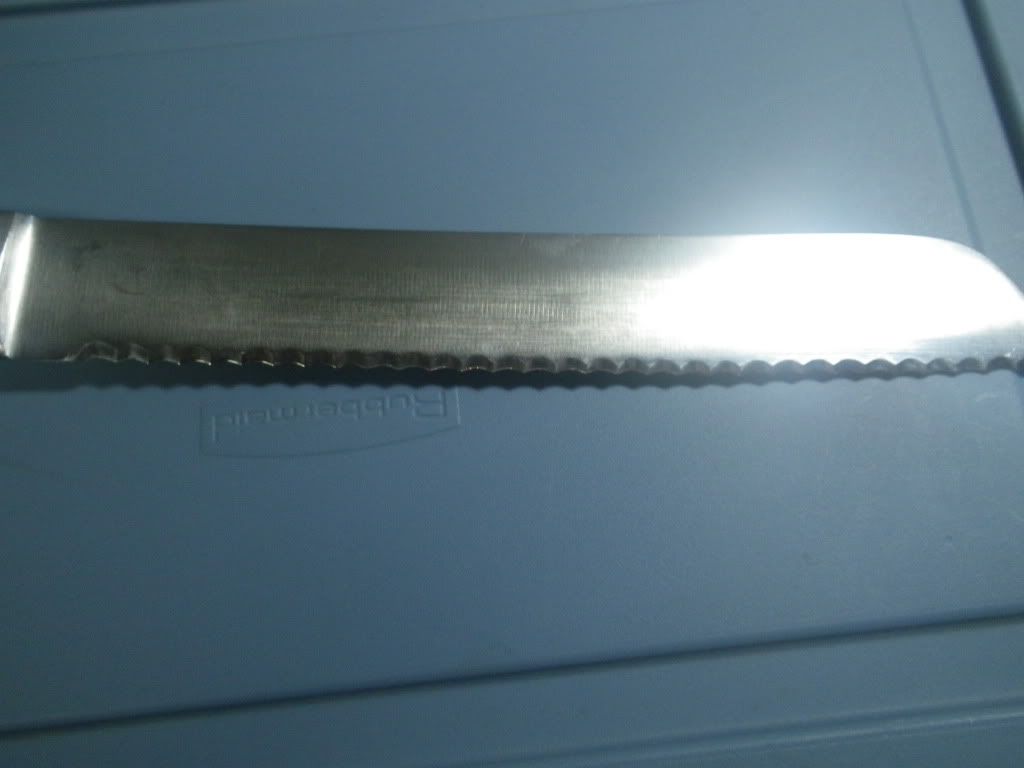 Picture here is an older Grohmann serrated knife that I had just finished. I had a good idea on how to do justice to these knives but I knew just who to contact to make sure. The following is not my idea but something I built upon and added some of my own touches to.
Picture here is an older Grohmann serrated knife that I had just finished. I had a good idea on how to do justice to these knives but I knew just who to contact to make sure. The following is not my idea but something I built upon and added some of my own touches to.
I have a ceramic rod that fits perfectly into the serrations by the way but I still wanted to improve my skills.
When I asked my colleagues, (other people with sharpening fixations) how they do these knives the most common answer was: "we don't" many sharpeners will not sharpen serrated knives and will avoid them.
I would prefer to stick to the straight edge but I recognize the need to have these ones sharpened, and fortunately, they really only need to be done once a year at most.
So with a serrated you have the serrated side obviously and then the flat side of the knife.
Here is the serrated side that I have done.
Each and every single little scalloped indentation needs some attention.
Here is the flat side and some people will only sharpen this side of the knife. Doing so will definitely sharpen your knife that's avoiding 50% of the blade...it is isn't it??
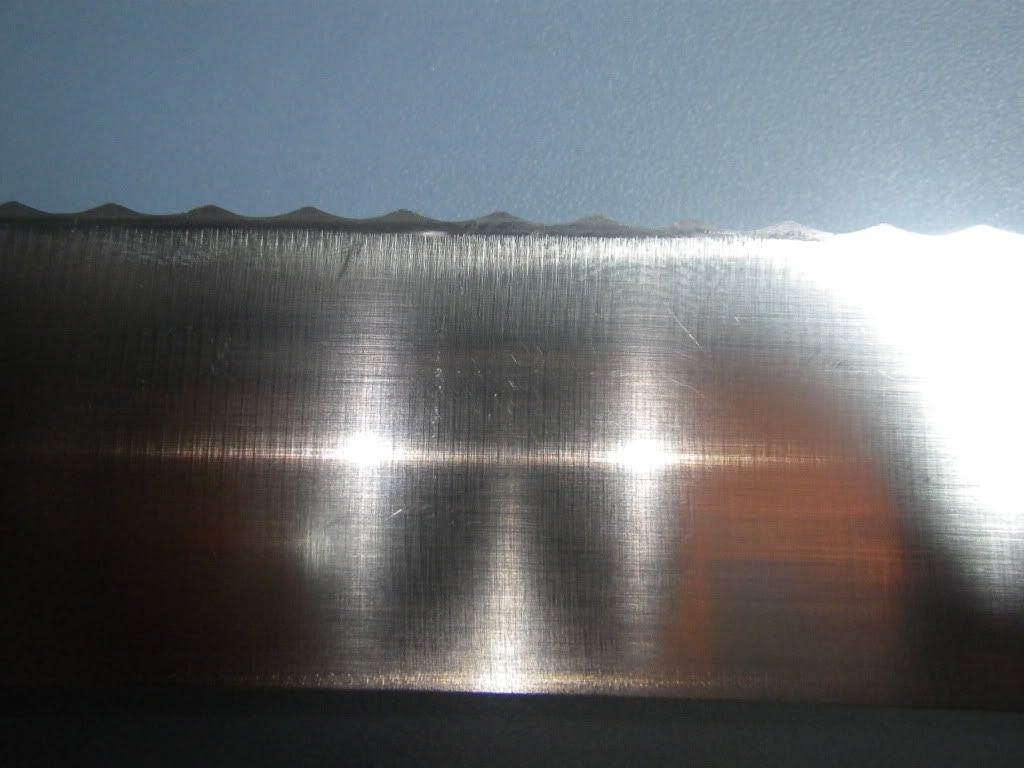 You may notice that I've sharpened this side as well with a nice progression of stones to ensure it was adequately sharpened and that bread will fear this knife.
You may notice that I've sharpened this side as well with a nice progression of stones to ensure it was adequately sharpened and that bread will fear this knife.
Again, with advice from my much smarter friend in the States, I decided to tackle both sides of the blade.
One of materials that are useful in sharpening and easily available is sandpaper. I am talking micro abrasives in a large variety of grits from 220 up to 1 micron.
I purchased some metal rods in various diameters and the micro abrasives and then I selected the rod that fit into serrations of this knife. Now the ceramic rod that I have fits perfectly and I also found that my screwdriver "barrels" did as well. The beauty of the screwdriver is that they have a handle. I simply cut out pieces of the abrasives, and then wrapped them around the screwdriver barrel and with a trailing motion I pulled the "rods" against the serrations. I repeated the process in every grit and the result was a sharpened serrated blade.
Here are the SSIT's (Serration Sharpening Improvised Tools) that I used:
While they are not pretty, the result was very good.
The smaller rods are for the smaller serrations such as those found in a tomato knife.
I may have beaten the serrated knife, as of this moment, I no longer fear sharpening it.
WHO's the MAN?
 Picture here is an older Grohmann serrated knife that I had just finished. I had a good idea on how to do justice to these knives but I knew just who to contact to make sure. The following is not my idea but something I built upon and added some of my own touches to.
Picture here is an older Grohmann serrated knife that I had just finished. I had a good idea on how to do justice to these knives but I knew just who to contact to make sure. The following is not my idea but something I built upon and added some of my own touches to.I have a ceramic rod that fits perfectly into the serrations by the way but I still wanted to improve my skills.
When I asked my colleagues, (other people with sharpening fixations) how they do these knives the most common answer was: "we don't" many sharpeners will not sharpen serrated knives and will avoid them.
I would prefer to stick to the straight edge but I recognize the need to have these ones sharpened, and fortunately, they really only need to be done once a year at most.
So with a serrated you have the serrated side obviously and then the flat side of the knife.
Here is the serrated side that I have done.
Each and every single little scalloped indentation needs some attention.
Here is the flat side and some people will only sharpen this side of the knife. Doing so will definitely sharpen your knife that's avoiding 50% of the blade...it is isn't it??
 You may notice that I've sharpened this side as well with a nice progression of stones to ensure it was adequately sharpened and that bread will fear this knife.
You may notice that I've sharpened this side as well with a nice progression of stones to ensure it was adequately sharpened and that bread will fear this knife.Again, with advice from my much smarter friend in the States, I decided to tackle both sides of the blade.
One of materials that are useful in sharpening and easily available is sandpaper. I am talking micro abrasives in a large variety of grits from 220 up to 1 micron.
I purchased some metal rods in various diameters and the micro abrasives and then I selected the rod that fit into serrations of this knife. Now the ceramic rod that I have fits perfectly and I also found that my screwdriver "barrels" did as well. The beauty of the screwdriver is that they have a handle. I simply cut out pieces of the abrasives, and then wrapped them around the screwdriver barrel and with a trailing motion I pulled the "rods" against the serrations. I repeated the process in every grit and the result was a sharpened serrated blade.
Here are the SSIT's (Serration Sharpening Improvised Tools) that I used:
While they are not pretty, the result was very good.
The smaller rods are for the smaller serrations such as those found in a tomato knife.
I may have beaten the serrated knife, as of this moment, I no longer fear sharpening it.
WHO's the MAN?
Chef's knives - My pot of gold
We all admire the Executive Chef, shows on TV like Hell's Kitchen have educated me, I have a better appreciation of what they need to be able to accomplish in order to be successful. I'm sure that for many, the cooking part is perhaps the easiest because it is in their blood. Organizing, time management, forward thinking and leadership are all key elements no doubt and don't come easily for all.
For me, when I think of an Executive Chef I think of two things right away:
I don't think that this is reason that I have yet to get hold of as many Chef's knives as I have, i.e. lack of a qualification. Part of it is the fact that they are taught to sharpen knives in culinary school and it becomes a part of their routine. I'm not saying that I can sharpen a knife as well as an Executive Chef. What I am saying is:
I can sharpen a knife as well as an Executive Chef. :) A chefs priority is cooking preceded by food preparation plus a million other things, over time he or she perhaps is just too busy to spend the time on a knife that they would like. I believe the ability is there but it's just not that easy to find the time. Chefs are quite educated when it comes to knives and maintaining them with steel is something they no doubt excel at. I on the other hand obsess with taking the edge of a knife to a level of sharpness that is well beyond what is actually required to cut food. I am focused on only one thing, sharpening , I'm not distracted by the cooking part. I spend hours watching videos, talking to other sharpeners in places like South Africa and I purchase products that have greatly enhanced the entire process of sharpening a knife. Now it is just a matter of gaining trust and that is something I absolutely, 100% understand. A person who owns a Lexus isn't going to take to someone that he doesn't know to work on it. Also, another factor is cost, why pay someone if I can do it myself?
Good question eh. The answer is simple though, because you want that knife to be screaming sharp and if there is a chance that some old bald guy who peers into a 20X loupe looking for scratch patterns on bevels in between grits, someone who has purchased exquisite diamond sprays with particles measured in fractions of microns. If there a chance that this man can get that knife sharper than it has ever been, and it will make my cooking experience more enjoyable and easier, and save time, than maybe I should check it out. If cost is a factor, than fear not, my prices are low, too low in fact for the amount of time I spend on a knife.
The bottom line is that Executive Chef's have very special talents and are learned in the art of food preparation and everything associated with that, I can't begin to imagine the myriad of skills they possess.
All I need to know however is how to sharpen a knife and Chefs are among the few who realize that it isn't like putting something in a toaster. I will finish by saying this "I am one heck of a toaster folks, in fact, I live and breathe toasters :)
(The picture has nothing to do of course with sharpening, it is just a unique item, like great chefs and sharpeners like me, thirsty for steel to quench their hunger for perfection.)
I would like to take the biggest, dullest knife a chef owns home and work on it at absolutely no cost to anyone but me and my time. If the finished product is something that is impressive..cool, if not, what's the harm? I would not make this statement however if I was not convinced that anyone would be anything less that 100 percent satisfied. The stones I own and covet have magical properties that produced an edge many have never seen. I'm just the old fella that is on the other end of those stones.
Did I mention that I polish knives too and we haven't even reached the stropping stage yet, you gotta hear about the leather and balsa strops folk..gees:)
(Oh by the way, I picked up the little blue teapot in Japan when I was there searching for that old fella that polishes swords)
For me, when I think of an Executive Chef I think of two things right away:
- How great it must be to have the knowledge of food and food preparation that they do; and
- What type of knives do they own and how do I get hold of them.
I don't think that this is reason that I have yet to get hold of as many Chef's knives as I have, i.e. lack of a qualification. Part of it is the fact that they are taught to sharpen knives in culinary school and it becomes a part of their routine. I'm not saying that I can sharpen a knife as well as an Executive Chef. What I am saying is:
I can sharpen a knife as well as an Executive Chef. :) A chefs priority is cooking preceded by food preparation plus a million other things, over time he or she perhaps is just too busy to spend the time on a knife that they would like. I believe the ability is there but it's just not that easy to find the time. Chefs are quite educated when it comes to knives and maintaining them with steel is something they no doubt excel at. I on the other hand obsess with taking the edge of a knife to a level of sharpness that is well beyond what is actually required to cut food. I am focused on only one thing, sharpening , I'm not distracted by the cooking part. I spend hours watching videos, talking to other sharpeners in places like South Africa and I purchase products that have greatly enhanced the entire process of sharpening a knife. Now it is just a matter of gaining trust and that is something I absolutely, 100% understand. A person who owns a Lexus isn't going to take to someone that he doesn't know to work on it. Also, another factor is cost, why pay someone if I can do it myself?
Good question eh. The answer is simple though, because you want that knife to be screaming sharp and if there is a chance that some old bald guy who peers into a 20X loupe looking for scratch patterns on bevels in between grits, someone who has purchased exquisite diamond sprays with particles measured in fractions of microns. If there a chance that this man can get that knife sharper than it has ever been, and it will make my cooking experience more enjoyable and easier, and save time, than maybe I should check it out. If cost is a factor, than fear not, my prices are low, too low in fact for the amount of time I spend on a knife.
The bottom line is that Executive Chef's have very special talents and are learned in the art of food preparation and everything associated with that, I can't begin to imagine the myriad of skills they possess.
All I need to know however is how to sharpen a knife and Chefs are among the few who realize that it isn't like putting something in a toaster. I will finish by saying this "I am one heck of a toaster folks, in fact, I live and breathe toasters :)
(The picture has nothing to do of course with sharpening, it is just a unique item, like great chefs and sharpeners like me, thirsty for steel to quench their hunger for perfection.)
I would like to take the biggest, dullest knife a chef owns home and work on it at absolutely no cost to anyone but me and my time. If the finished product is something that is impressive..cool, if not, what's the harm? I would not make this statement however if I was not convinced that anyone would be anything less that 100 percent satisfied. The stones I own and covet have magical properties that produced an edge many have never seen. I'm just the old fella that is on the other end of those stones.
Did I mention that I polish knives too and we haven't even reached the stropping stage yet, you gotta hear about the leather and balsa strops folk..gees:)
(Oh by the way, I picked up the little blue teapot in Japan when I was there searching for that old fella that polishes swords)
Saturday 15 October 2011
Hunting knives - different kettle of fish
Hello there. This is a Grohmann hunting knife that I used when I was at sea. (They make a great seaman's knife). It didn't look like this at the time of course and this one is about 10 years old. The picture doesn't do the bevel justice but you can see what a nice polish the knife takes. It is a slightly different process that I use on the micro edge these knives. I don't put a mirror edge on the cutting edge (micro edge) of a kitchen knife because we need to have a bit of bite on the cutting edge. On a hunting knife however, the mirror finish lends on the bevel and the micro edge lends itself to improved cutting so I use the higher grit stones on the edge of a hunting knife. I use those same stones as polishing stones on the relief angle of kitchen knives. Clear as mud eh :)
I don't get the opportunity to do many hunting knives and relish the opportunity when I do. I charge about a million dollars for these ones though :)
Sunday 9 October 2011
Saturday 8 October 2011
New business
Hi folks.
I'll be registering my business shortly and have a name locked in for it now.
New Edge Sharpening is the name of my business. I also wanted to let you know about something the Manager at Paderno and I have done there to add some extra options for folks when it comes to sharpening. It is called Custom Sharpening and people will be able to choose from 3 different edges on their kitchen knives. It is important to note that each and every edge, no matter what the choice is will result in a very sharp knife which will be at least as sharp as when new and in most cases beyond that.
The Essential Edge is for everyday cooks and everyday knives, many people have average quality kitchen knives and are really only interested in getting it re-sharpened at an affordable price. Knives are finished with a 2K grit and all nicks and chips are removed. It's going to make your knives very sharp and folks thus far have been very happy.
The Performance Edge is a step above with the finishing stone being 5,000 grit, the blade will be polished and stropped on leather laden with a diamond paste at 1 micron. Precise angles on the bevels are of course part of all the packages and you can even choose an angle. I'll polish the blade, touch up the handle if need be and this knife will be returned screaming sharp and looking pretty. It is only 10-15 dollars a knife depending on the size of the blade with 7 inches being the magic number. I spend a lot of time on these knives, 10 bucks is less than minimum wage and you will be surprised how sharp the edge will be.
The Executive Edge is for professional chefs and avid home cooks but also will appeal to absolutely everyone who just loves a sharp knife. You do not need special knives to get these edges but you also don't NEED this sharp a knife to be honest. However, we don't need Rolex's or a Lexus, we just like those beautiful things and the Executive Edge will produce a very nice looking knife. It will be treated to some extra care with a Relief Angle being applied and a very pretty and effective mirror like bevel. The edge is sharpened at two angles with the relief angle getting a 15,000 grit polishing with the finest Japanese Water Stones on the market. The cutting edge, or micro edge if you wish will be at 5k and stropped on special balsa plates laden with very exclusive diamond sprays that I get from a gentleman in California. This knife is intensely sharp, it looks great and is fun to use at 15-20 bucks. I will spend a minimum of an hour on a small knife.
The Essential Edge is good enough for everyone though, it's going to be nice and sharp and with regular maintenance by the owner with steel it will stay sharp and its only 6-8 bucks a pop, ridiculously inexpensive but it's important for everyone to be able to have a sharp knife and not pay a lot for it. I don't charge for a lot of little extras that I do, I treat each knife as if it were my own.
I love to sharpen....did I mention that?
These are just some extra options for folks, I have some very special sharpening products, people should be able to take advantage of them.
I'll be registering my business shortly and have a name locked in for it now.
New Edge Sharpening is the name of my business. I also wanted to let you know about something the Manager at Paderno and I have done there to add some extra options for folks when it comes to sharpening. It is called Custom Sharpening and people will be able to choose from 3 different edges on their kitchen knives. It is important to note that each and every edge, no matter what the choice is will result in a very sharp knife which will be at least as sharp as when new and in most cases beyond that.
The Essential Edge is for everyday cooks and everyday knives, many people have average quality kitchen knives and are really only interested in getting it re-sharpened at an affordable price. Knives are finished with a 2K grit and all nicks and chips are removed. It's going to make your knives very sharp and folks thus far have been very happy.
The Performance Edge is a step above with the finishing stone being 5,000 grit, the blade will be polished and stropped on leather laden with a diamond paste at 1 micron. Precise angles on the bevels are of course part of all the packages and you can even choose an angle. I'll polish the blade, touch up the handle if need be and this knife will be returned screaming sharp and looking pretty. It is only 10-15 dollars a knife depending on the size of the blade with 7 inches being the magic number. I spend a lot of time on these knives, 10 bucks is less than minimum wage and you will be surprised how sharp the edge will be.
The Executive Edge is for professional chefs and avid home cooks but also will appeal to absolutely everyone who just loves a sharp knife. You do not need special knives to get these edges but you also don't NEED this sharp a knife to be honest. However, we don't need Rolex's or a Lexus, we just like those beautiful things and the Executive Edge will produce a very nice looking knife. It will be treated to some extra care with a Relief Angle being applied and a very pretty and effective mirror like bevel. The edge is sharpened at two angles with the relief angle getting a 15,000 grit polishing with the finest Japanese Water Stones on the market. The cutting edge, or micro edge if you wish will be at 5k and stropped on special balsa plates laden with very exclusive diamond sprays that I get from a gentleman in California. This knife is intensely sharp, it looks great and is fun to use at 15-20 bucks. I will spend a minimum of an hour on a small knife.
The Essential Edge is good enough for everyone though, it's going to be nice and sharp and with regular maintenance by the owner with steel it will stay sharp and its only 6-8 bucks a pop, ridiculously inexpensive but it's important for everyone to be able to have a sharp knife and not pay a lot for it. I don't charge for a lot of little extras that I do, I treat each knife as if it were my own.
I love to sharpen....did I mention that?
These are just some extra options for folks, I have some very special sharpening products, people should be able to take advantage of them.
Friday 30 September 2011
Global
Now here is a beautiful knife. The Global which I had just finished and I think the owner will be pleased. Global knives are Japanese and truly enjoyable and rewarding to sharpen. These knives are very sharp right out of the box. You cannot go wrong with these. I will have shots of other beautiful knives as well like Grohmann, Wusthof, Henckels and more.
Why so sharp
There are several factors that have enabled me to create edges on kitchen knives that are screaming sharp.
The first and most important is a sheer passion for the art. I constantly challenge myself to improve and quite simply, I thoroughly enjoy the process. Without this, you wouldn't be reading this because there would be no Blog.
Practice of course, reading, watching and learning from mentors, nothing unusual here, it's the basic recipe for reaching a state where you are able to gain satisfaction with something you do. One of the key elements in my inventory, an item that allows me to do what I do is this particular stone.
This is is a 5K Shapton Pro stone that again is cut specifically to fit into my stone arm of the Edge Pro Professional. When I first heard of this brand of Japanese Water Stone I read claims of their quality and knew that at some point in time I would own one of these coveted items. The 5K Shapton seen here is said to deliver an edge that few people have experienced. I have had the pleasure of experiencing it and it is absolutely true, well certainly in my case. The knives I have sharpened with this stone in the lineup have been truly something you have to see for yourself to believe. I made a mistake on the first knife I did with this stone, the edge just very lightly touched my wrist and a crimson line developed and then the blood flowed. It was like a scalpel on my skin, there was no pain at all.
I have the 15K Shapton as well, imagine what that will do :) .
The first and most important is a sheer passion for the art. I constantly challenge myself to improve and quite simply, I thoroughly enjoy the process. Without this, you wouldn't be reading this because there would be no Blog.
Practice of course, reading, watching and learning from mentors, nothing unusual here, it's the basic recipe for reaching a state where you are able to gain satisfaction with something you do. One of the key elements in my inventory, an item that allows me to do what I do is this particular stone.
This is is a 5K Shapton Pro stone that again is cut specifically to fit into my stone arm of the Edge Pro Professional. When I first heard of this brand of Japanese Water Stone I read claims of their quality and knew that at some point in time I would own one of these coveted items. The 5K Shapton seen here is said to deliver an edge that few people have experienced. I have had the pleasure of experiencing it and it is absolutely true, well certainly in my case. The knives I have sharpened with this stone in the lineup have been truly something you have to see for yourself to believe. I made a mistake on the first knife I did with this stone, the edge just very lightly touched my wrist and a crimson line developed and then the blood flowed. It was like a scalpel on my skin, there was no pain at all.
I have the 15K Shapton as well, imagine what that will do :) .
A nice haul
This is a nice batch of very nice knives that I am currently working on. I don't always have this many at once and I like to do about five per night at most. I'll spend anywhere from 30 minutes to 1.5 hours per knife depending on each knife and what the customer would like. I offer a custom package where the owner can choose how sharp he/she would like the knife to be. The ultimate edge involves creating the relief angle and using a large selection of stones and ultimately ending up with a mirror finish on the bevel. Then I'll raise the angle and sharpen the edge itself with the same stones but usually finishing up with the 5K Shapton. This is not the end of the process though.
The ultimate edge (That is just a term selected to sound nice, it's just an extremely sharp edge, and by extremely sharp, it is an edge that most people have not experienced - I will explain that soon)
I will finish the job with a stropping. I use balsa strops fitted to metal plates that fit my Edge Pro and are laden with diamond compounds. (picture soon). I use leather strops as well but prefer the balsa.
Tuesday 27 September 2011
Customers - How do I find them and how do they find me?
Without my friendly customers, I would have no knives to sharpen and nothing to feed my obsession except for my own personal knives and those of the family. Where do my customers come from and how do they know about what I have to offer? This is for me the biggest challenge and the only barrier to my dream of sharpening knives on a full time basis. The actual art of sharpening is something I am comfortable with and I would not offer to sharpen a knife and expect payment unless I was perfectly comfortable that the owner who was good enough to trust me with the knife in the first place was satisfied and pleasantly surprised at the result. Paderno in Bayer's Lake is the primary source, the good Manager there readily agreed to allow customers to drop off their knives there, I pick them up, do my thing at home and then drop them off at Paderno. It is convenient for folks this way and they have also have some signs up in the store that advertises knife sharpening.
Another way is that folks pick up my Business Card at Cucina Moderna at one of their 3 locations, again, the fine Manager has agreed to allow me to leave my cards in the stores and occasionally people who are interested in getting someone else to sharpen their knives pick up my card and we go from there once contact is made. I am extremely grateful for this, without Paderno or Cucina Moderna I would not have the volume of customers that I do.
Of course, word of mouth is doing what it does best and I get calls frequently from people who just want sharp knives. This has worked well and occasionally I even get knives shipped to me from other Provinces.
Basically, I get knives from all sorts of folks and they all range in quality and age. I have had a knife given to me that was 55 years old and have also received knives still in the box, brand spanking new that the owner want's a razor edge applied. Although this is a business for me now, I have not reached the stage that I look at it that way. I get excited at every knife that I get at home to sharpen, it is a thrill for me to restore the edge to the at the very least the factory edge and then the real fun begins, the stage beyond the factory edge :)
To date, the most rewarding sharpening service, and they are all rewarding, was one for an older gentleman. He gave me a very large and beautiful hunting knife to sharpen. Three days after I returned it, he delivered it to me, gift wrapped and told me that I did such a good job that I deserved to keep it.
You gotta love happy customers :)
Pete
Another way is that folks pick up my Business Card at Cucina Moderna at one of their 3 locations, again, the fine Manager has agreed to allow me to leave my cards in the stores and occasionally people who are interested in getting someone else to sharpen their knives pick up my card and we go from there once contact is made. I am extremely grateful for this, without Paderno or Cucina Moderna I would not have the volume of customers that I do.
Of course, word of mouth is doing what it does best and I get calls frequently from people who just want sharp knives. This has worked well and occasionally I even get knives shipped to me from other Provinces.
Basically, I get knives from all sorts of folks and they all range in quality and age. I have had a knife given to me that was 55 years old and have also received knives still in the box, brand spanking new that the owner want's a razor edge applied. Although this is a business for me now, I have not reached the stage that I look at it that way. I get excited at every knife that I get at home to sharpen, it is a thrill for me to restore the edge to the at the very least the factory edge and then the real fun begins, the stage beyond the factory edge :)
To date, the most rewarding sharpening service, and they are all rewarding, was one for an older gentleman. He gave me a very large and beautiful hunting knife to sharpen. Three days after I returned it, he delivered it to me, gift wrapped and told me that I did such a good job that I deserved to keep it.
You gotta love happy customers :)
Pete
Monday 26 September 2011
Testimonial
Hi there, a very kind professional chef was good enough to let me sharpen her knives recently, I asked her if she was pleased and this was her response:
Hi Pete,
"Pleased" is a gross understatement; in fact, I don't really know how to
adequately express my appreciation of the phenomenal job you've done.
I never expected you to be able the repair the tip of my favourite French
knife.There is much filleting of fish and boning of meat going on at home, as I
look for anything and everything to slice and dice. I'm serving beef
carpaccio at an upcoming dinner party and can't wait to use the slicer.
I have already been raving about the job you did to everyone I know, and
have passed out your business cards--for sharpening knives, there is no
comparison to the job you do, none! Feel free to use this email if you need
a reference or wish to post it online as a testimonial.
WESTIN NOVA SCOTIAN, HALIFAX, NOVA Scotia
I have some references if needed, just give me a holler or email at
i_zar_2@hotmail.com
Hi Pete,
"Pleased" is a gross understatement; in fact, I don't really know how to
adequately express my appreciation of the phenomenal job you've done.
I never expected you to be able the repair the tip of my favourite French
knife.There is much filleting of fish and boning of meat going on at home, as I
look for anything and everything to slice and dice. I'm serving beef
carpaccio at an upcoming dinner party and can't wait to use the slicer.
I have already been raving about the job you did to everyone I know, and
have passed out your business cards--for sharpening knives, there is no
comparison to the job you do, none! Feel free to use this email if you need
a reference or wish to post it online as a testimonial.
WESTIN NOVA SCOTIAN, HALIFAX, NOVA Scotia
I have some references if needed, just give me a holler or email at
i_zar_2@hotmail.com
Saturday 24 September 2011
Japanese Water Stones
Hi folks, so just what the heck are these Japanese Water Stones I talk about?
When I first started sharpening as a young sailor at sea, I used an oil stone which many folks find perfectly fine for taking care of their edges. As my obsession for learning about sharpening and how to improve commenced I found an article on JWS (Japanese Water Stones) and my obsession/passion took on a new path. I was kind of hooked before, now I was addicted. As in everything else on the market, stones come in various varieties and differ in quality. The ones I use are synthetic as most are and are absolutely remarkable. There are natural JWS of course that can be used, generally more expensive, harder to get and not something I plan on looking at just now. Many of the sharpeners I liaise with who have both prefer the synthetic type and all agree that they perform what they designed for wonderfully. There are three broad categories of JWS, the Ara-to (rough stone), the Naka-to (medium stone) and the Shiage-to (finishing stone).
Here is a JWS, King brand at 800 grit. This is a great stone for starting on a dull knife, it is aggressive, easy to use and cheap to purchase. (Less then $30.00). This is one of the stones I started with after switching from oil stones to Japanese Water Stones.
Now however I use a higher quality JWS that is cut to a specific size for me by a gentleman in California who purchases these very high quality stones from Japan. I use stones specifically designed for my system by a brilliant sharpener who has sharpened over 100,000 knives on the device he created.
I use a combinaton of JWS including Naniwa Chosera and Shapton in a wide variety of grits. Here is what they look like:
The picture here is a beautiful 10,000 grit Chosera stone that has been specifically cut to fit into the "stone-arm" of my Edge Pro Professional.
These are the stones that I use to take the edge of a very dull knife to a screaming sharp and enjoyable to use knife. Whether it is a nice Global, Shun or just a no-name brand that needs some TLC.
When I first started sharpening as a young sailor at sea, I used an oil stone which many folks find perfectly fine for taking care of their edges. As my obsession for learning about sharpening and how to improve commenced I found an article on JWS (Japanese Water Stones) and my obsession/passion took on a new path. I was kind of hooked before, now I was addicted. As in everything else on the market, stones come in various varieties and differ in quality. The ones I use are synthetic as most are and are absolutely remarkable. There are natural JWS of course that can be used, generally more expensive, harder to get and not something I plan on looking at just now. Many of the sharpeners I liaise with who have both prefer the synthetic type and all agree that they perform what they designed for wonderfully. There are three broad categories of JWS, the Ara-to (rough stone), the Naka-to (medium stone) and the Shiage-to (finishing stone).
Here is a JWS, King brand at 800 grit. This is a great stone for starting on a dull knife, it is aggressive, easy to use and cheap to purchase. (Less then $30.00). This is one of the stones I started with after switching from oil stones to Japanese Water Stones.
Now however I use a higher quality JWS that is cut to a specific size for me by a gentleman in California who purchases these very high quality stones from Japan. I use stones specifically designed for my system by a brilliant sharpener who has sharpened over 100,000 knives on the device he created.
I use a combinaton of JWS including Naniwa Chosera and Shapton in a wide variety of grits. Here is what they look like:
The picture here is a beautiful 10,000 grit Chosera stone that has been specifically cut to fit into the "stone-arm" of my Edge Pro Professional.
These are the stones that I use to take the edge of a very dull knife to a screaming sharp and enjoyable to use knife. Whether it is a nice Global, Shun or just a no-name brand that needs some TLC.
Friday 16 September 2011
The Edge
There are many methods available out there to sharpen your knife. I just happen to prefer the use of the stones, it is very rewarding and therapeutic form of sharpening and in the vast majority of cases it is very successful. It is not difficult to take the edge of a knife to a degree of sharpness that is beyond the factory edge or "out of the box" sharpness. Do we really need the knife to be that sharp, no we don't. However, I don't think anyone could argue that the sharper it is, the better it is. The key, for me though is to not just producing an edge that is sharp enough to shave with but also one that will stay sharp for a long period of time. Maintaining the edge with a steel of course is paramount and good practice to follow very regularly.
A Relief Angle is something I often put on good kitchen knives, it is merely a secondary angle behind the micro bevel. Basically, you have the edge, the very thin cutting portion of the knife and then you have the bevel. On most knives, certainly German knives for example there is a bevel on each side and then. The relief angle is applied to the section between the bevel and heel of the knife.
In this picture you can clearly see the line created by sharpening at two different angles.
This knife was sharpened first at a 13 degree angle to form the Relief Angle, while not clearly visible here it has a mirror like edge to it. Then the micro bevel, was sharpened at 18 degrees to create an extremely sharp knife and one that will retain the edge for some time. When cutting food, the food will slide up the relief angle which has formed a tiny ramp, it makes cutting easier. The beauty of this technique is that the edge is very easy to resharpen, I only need to work on the micro bevel. It is also a very attractive look to those who care about such things....I care about such things :). Most folks are not really concerned about this type of thing, however, most do appreciate a sharp knife. Whether you get it that way from Japanese Water Stones, oil stones, belt sanders or electric grinders, there is no doubt in my mind that everyone appreciates the final product. I just happen to be the one of the people that enjoys the entire process.
A Relief Angle is something I often put on good kitchen knives, it is merely a secondary angle behind the micro bevel. Basically, you have the edge, the very thin cutting portion of the knife and then you have the bevel. On most knives, certainly German knives for example there is a bevel on each side and then. The relief angle is applied to the section between the bevel and heel of the knife.
In this picture you can clearly see the line created by sharpening at two different angles.
 |
| Relief Angle |
This knife was sharpened first at a 13 degree angle to form the Relief Angle, while not clearly visible here it has a mirror like edge to it. Then the micro bevel, was sharpened at 18 degrees to create an extremely sharp knife and one that will retain the edge for some time. When cutting food, the food will slide up the relief angle which has formed a tiny ramp, it makes cutting easier. The beauty of this technique is that the edge is very easy to resharpen, I only need to work on the micro bevel. It is also a very attractive look to those who care about such things....I care about such things :). Most folks are not really concerned about this type of thing, however, most do appreciate a sharp knife. Whether you get it that way from Japanese Water Stones, oil stones, belt sanders or electric grinders, there is no doubt in my mind that everyone appreciates the final product. I just happen to be the one of the people that enjoys the entire process.
Thursday 15 September 2011
So it begins
The first tool I use on a dull knife, and any knife I get is dull is a DMT Extra Course diamond plate.
The use of this plate is a crucial component of my sharpening. It is perfectly flat and will re-establish the bevel at whatever angle I choose, which in most cases is the factory angle. Once I have completed a few passes on each side of knife with this, I move to the Japanese Water Stones. This is also perfect for removing nicks in the blade, and remember, if you can't see the nicks they are there, this plate will find them and remove them.
The use of this plate is a crucial component of my sharpening. It is perfectly flat and will re-establish the bevel at whatever angle I choose, which in most cases is the factory angle. Once I have completed a few passes on each side of knife with this, I move to the Japanese Water Stones. This is also perfect for removing nicks in the blade, and remember, if you can't see the nicks they are there, this plate will find them and remove them.
Monday 12 September 2011
Sharpening a knife
The first thing I do when someone gives me a knife to sharpen is to examine the edge for nicks. Not all damage is visible to the naked eye so I use an LED powered 15X Loupe which allows me to get a really close up look at the edge, the cutting part of the knife. There are times when the blade is so damaged that before I start using the stones I bring out the belt sander equipped with the sharpening belts. This tool allows me to remove metal and reshape the edge and basically return it to it's original shape. Now I can actually sharpen the knife and this is where for me, the fun starts.This is where the cost of all of those Japanese Water Stones and my guided device, The Edge Pro Professional starts to pay off.
Perhaps you can understand better if you are familiar with some of the most basic parts of the a knife. Did you know that many knives are stamped from a single piece of metal and sharpened on a machine, a grinder. A robotic arm is just part of an automated process that ultimately forms our beloved kitchen knives. Regardless of the process that is used to take the metal from it's original state, ore, high carbon steel, stainless steel or a blend of carbons into what we purchase, each knife eventually becomes dull from use.
My passion is to restore the edge of the knife to not only the same degree of sharpness as the day it was purchased but to take it beyond that and transform the dull knife into a beautifully sharpened instrument that enhances your food preparation experience and makes you feel good about buying that knife again.
Here you go, perhaps having this to look at will help you understand just what it is I do next, i.e. the sharpening or re-sharpening, the fun part. What this picture does not show is the bevel, that portion of the knife that is the angled piece on each side directly behind the edge and this is the part that I work on.

Perhaps you can understand better if you are familiar with some of the most basic parts of the a knife. Did you know that many knives are stamped from a single piece of metal and sharpened on a machine, a grinder. A robotic arm is just part of an automated process that ultimately forms our beloved kitchen knives. Regardless of the process that is used to take the metal from it's original state, ore, high carbon steel, stainless steel or a blend of carbons into what we purchase, each knife eventually becomes dull from use.
My passion is to restore the edge of the knife to not only the same degree of sharpness as the day it was purchased but to take it beyond that and transform the dull knife into a beautifully sharpened instrument that enhances your food preparation experience and makes you feel good about buying that knife again.
Here you go, perhaps having this to look at will help you understand just what it is I do next, i.e. the sharpening or re-sharpening, the fun part. What this picture does not show is the bevel, that portion of the knife that is the angled piece on each side directly behind the edge and this is the part that I work on.
Subscribe to:
Posts (Atom)



